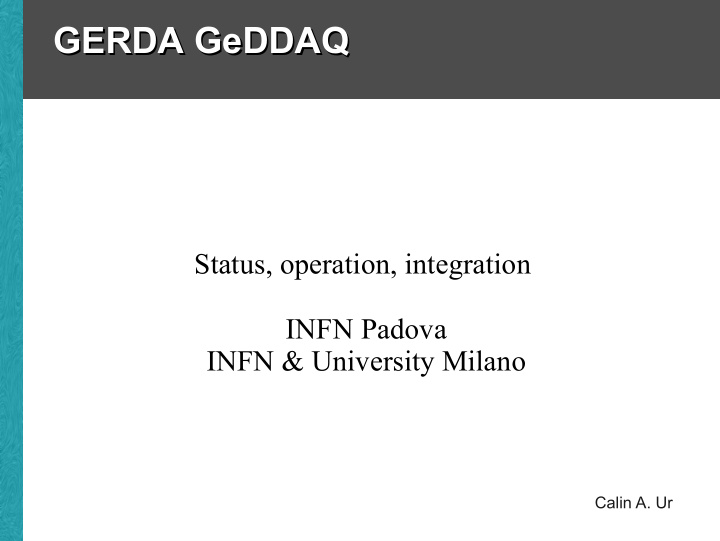



GERDA GeDDAQ GERDA GeDDAQ Status, operation, integration INFN Padova INFN & University Milano Calin A. Ur
The GeDDAQ System The GeDDAQ System Channels 4/module Channels FADC bits 14 FADC rate (MHz) 100 Internal trigger yes Trace length (samples) 1024 @ 25 MHz 512 @ 100 MHz Control & i/f NIM/PCI Data transfer DMA PCI 32bit/33MHz Max output rate (MB/s) 132 (no write) 60 (write)
ChangeLog – new features&fixes ChangeLog – new features&fixes ● Implementation of the internal trigger HW/SW ● firmware Xilinx FPGA on NIM boards ● modified the NIM boards ● programming of the thresholds RS232 ● TTL ouput trigger signals ● Implemented the baseline monitor ● not yet tested ● Stabilized the data transfer in DMA ● 33MHz PCI ● revised firmware Altera FPGA – master/slave ● Rewrite the acq. codes ● more stable ● faster ● readable
Internal Trigger Internal Trigger Trigger algorithm (triangular filter) each channel separately Trigger logic 4 x TTL or (to be done) OR GUI Rx/Tx P (to be done) C
Tests in the Rimessa Lab Tests in the Rimessa Lab ● Tests with pulser – two NIM modules (8 channels) ● 50 ns rise time, 50 µ s decay time ● variable amplitude ● trigger 750 µ V on a 2V range Ch#0
Tests in the Rimessa Lab Tests in the Rimessa Lab 7 Cs and 2 1 Am) ● Tests with sources ( 6 0 Co, 1 3 4 ● LNGS BEGe detector @ ~1.5 kHz ● MWD ~7 µ s Full range ~6.65 MeV 0.63 keV 1.87 keV ~11 keV
Data Format Data Format Data are saved on disk - run number - files of max. 2 GB length (or a preset value) - automatic version increment Each file contains: *************** HEADER (ASCII) *************** ?PCIDAQ0 data label ?CHN0004 number of enabled channels ?WVN0002 number of waves for each channel (1 or 2) ?P101024 number of bins in the first wave (fixed) ?P200512 number of bins in the second wave ?D103000 how many 10 ns after trigger in the first wave ?D200450 how many 10 ns after trigger in the second wave ?SPR0016 output sample precision in bits ?BIT0014 number of FADC conversion bits ?FRQ0100 sampling frequency in MHz ?LTR0024 event trailer length in bytes ?CH10002 channel #1 Enable Pattern 0000000010 .........(channel #1 of card #2 is enabled; card #1 is LSB) ?CH20000 channel #2 Enable Pattern 0000000000 .........(no channels #2 enabled) ?CH30001 channel #3 Enable Pattern 0000000001 .........(channel #3 of card #1 is enabled) ?CH40002 channel #4 Enable Pattern 0000000011 .........(channel #4 of card #2 is enabled ?JHZ0100 frequency of jiffies (100 Hz) depends on the OS ?RUN0007 run number ?ORIGDAT original data ?U000029 user comment length (in bytes) "Data Conmment with User Comment Text" "new lines" ".............." up to 512 characters ?ENDHEAD end of header
Data Format Data Format *************** DATA BLOCK *************** 1st Event: Number_of_Channels_Enabled * ........................ 4 Number_of_Points_wave_1 * sizeof(u16) + ...... 1024 * 2 Number_of_Points_wave_2 * sizeof(u16) + ....... 512 * 2 Event_Trailer_Lentgh = ............................. 24 Event_Length = ...................................12312 bytes Event Trailer Format - 6 x u32 integers = 24 bytes #0 = Trigger counter (Event ID) #1 = Time stamp high (lowest value) #2 = Time stamp low #3 = Difference of time stamps for each card #4 = Data acqusition time measured in jiffies (10 ms) #5 = End Of Event = 0xFFFFFFFF 2nd Event: ....
Present Status Present Status Saturday morning
Present Status Present Status Saturday evening
Present Status Present Status System installed underground and ready to run in standalone mode Sunday evening
The Electronic Cabinet The Electronic Cabinet Analogue Electronics Digitizers Ge HV Power Supplies Trigger Logic Ethernet HD Trigger Box DAQ Computer
The Electronic Cabinet The Electronic Cabinet Analogue Electronics Digitizers Ge HV Power Supplies Trigger Logic Ethernet HD Trigger Box DAQ Computer
The Electronic Cabinet The Electronic Cabinet Analogue Electronics Digitizers Ge HV Power Supplies Trigger Logic Ethernet HD Trigger Box DAQ Computer
Minimum Working Conditions Minimum Working Conditions ● Chiller operational and controlled ● Temperature control of the cabinet ● Emergency stop system if ● chiller stops working ● temperature goes above alarm level ● Connection to the internet for remote control of the DAQ
Work still to be done Work still to be done ● GUI for the Ge energy threshold programming ● Test of the Ge signals baseline monitor and transmission to the SC ● Producing the OR of the trigger signals in the FPGA ● Logging the temperature of the cabinet for sta- bility analysis ● Logging the Start/Stop of the acquisition for SC ● Synchronization with the muon veto
Synchronization with muon veto Synchronization with muon veto ● Distribute the same sampling clock ● muon veto → GeDDAQ (50 MHz) ● re–shaping the signal ● Trigger & START signal ● GeDDAQ → muon veto ● TTL signal from PC parallel port (START) ● BUSY signal ● muon veto → GeDDAQ ● GeDDAQ ignores it in standalone mode ● Synchronization with analogue pulser of vari- able amplitude on dedicated channels of both systems ● Check for synchronization in real–time ● Who? how?
Recommend
More recommend